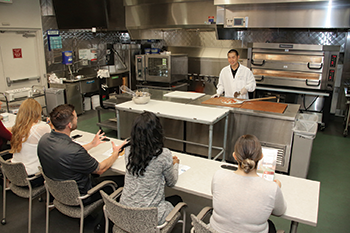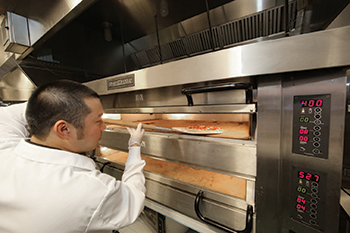As energy costs continue to soar, especially on the West Coast, restaurants continue to find new ways to save on utility costs. Luckily, more energy companies are there to help.
 The SCE Foodservice Technology Center assists foodservice operators with energy education, demo space and equipment testing. Photos courtesy of SCE Foodservice Technology CenterSince opening its Energy Education Center in Irwindale, Calif., electric utility company Southern California Edison (SCE) established a mission to educate its customers by hosting classes, offering demo opportunities and otherwise assisting restaurants with finding efficient equipment and solutions to reduce energy usage and costs — all for free. The Food Service Technology Center’s Southern California location includes a demonstration kitchen outfitted with the latest energy-efficient commercial foodservice equipment and technologies, such as combi ovens, connectionless steamers, griddles, advanced conveyor ovens, fryers, ice machines, and exhaust hoods. These and more items are available for commercial customers to test and conduct side-by-side comparison testing of multiple cooking capabilities. SCE also holds regular classes about how to reduce energy costs at the SCE facility in Irwindale.
The SCE Foodservice Technology Center assists foodservice operators with energy education, demo space and equipment testing. Photos courtesy of SCE Foodservice Technology CenterSince opening its Energy Education Center in Irwindale, Calif., electric utility company Southern California Edison (SCE) established a mission to educate its customers by hosting classes, offering demo opportunities and otherwise assisting restaurants with finding efficient equipment and solutions to reduce energy usage and costs — all for free. The Food Service Technology Center’s Southern California location includes a demonstration kitchen outfitted with the latest energy-efficient commercial foodservice equipment and technologies, such as combi ovens, connectionless steamers, griddles, advanced conveyor ovens, fryers, ice machines, and exhaust hoods. These and more items are available for commercial customers to test and conduct side-by-side comparison testing of multiple cooking capabilities. SCE also holds regular classes about how to reduce energy costs at the SCE facility in Irwindale.
In the Innovation Center, SCE customers can take a look at interactive displays and exhibits to learn more about how they can take advantage of energy efficient, cost-cutting solutions like variable speed drives, heat pump demonstrators, chilled water and variable air volume systems, T5, induction and LED high bay lighting, energy management systems and more.
Equipment Tests
“Any of our customers can come in and try out new equipment for the day or even for a couple weeks if they’re testing out a new concept or multiple menu items,” says Andre Saldivar, project manager at SCE.
Similar to how things run at the Food Service Technology Center, funded by Pacific Gas & Electric, in San Ramon, Calif., SCE also conducts its own third-party, energy efficiency testing to help customers make informed decisions based on needs.
“I can’t say manufacturer A is better than B, but I’m able to help the customer compare equipment based on technical aspects like temperature fluctuations, recovery and performance, especially when comparing different capabilities,” he says. “We also offer energy audits to help customers lower their gas and electric bills.”
While the center works with all types of restaurants and foodservice operators, from traditional brick-and-mortar chains to food trucks, prisons, school districts, parks, movie theaters and corporate cafeterias, recent efforts focus on mom-and-pop restaurants — those that arguably need energy education, demo space and assistance the most.
 Time and efficiency took precedence when it came to the right equipment for TJ’s Woodfire Pizza restaurant.One such restaurant, TJ’s Woodfire Pizza in San Clemente, Calif. — named the No. 1 local pizza restaurant by The Orange County Register — has already saved more than $1,000 in the first year since running energy audits and testing a new, more efficient oven at SCE’s Foodservice Technology Center. Owner Tim Gonzales also added more menu items at the same quality level in order to boost overall revenues.
Time and efficiency took precedence when it came to the right equipment for TJ’s Woodfire Pizza restaurant.One such restaurant, TJ’s Woodfire Pizza in San Clemente, Calif. — named the No. 1 local pizza restaurant by The Orange County Register — has already saved more than $1,000 in the first year since running energy audits and testing a new, more efficient oven at SCE’s Foodservice Technology Center. Owner Tim Gonzales also added more menu items at the same quality level in order to boost overall revenues.
One Operator’s Energy Journey
Prior to opening the brick-and-mortar restaurant in 2015, Gonzales operated TJ’s Woodfire Pizza as a food truck, using a wood-fired oven set up in a trailer for his Neapolitan-style pizzas. Part of the new oven research was to test out other styles of pizza, such as those influenced by Sicilian, New York and Chicago cracker crust pies. Primarily, however, time and efficiency took precedence for Gonzales. “We wanted to be efficient,” he says. “We have to run ovens throughout the day and we didn’t want costs to be through the roof or use a ton of energy.” Gonzales says he learned about the SCE Foodservice Technology Center and its demo space through a manufacturer, who recommended he test the equipment at that facility since the ovens were already available. Gonzales brought most of the ingredients necessary to conduct full-scale testing of all the new menu ideas, even going beyond pizza. SCE testing engineers were on hand to assist with questions — and they also became happy taste testers, Saldivar says. Gonzales was already using a high-temperature wood-fired oven for his classic Neapolitan-style pizza but wanted to consider other options while exploring a variety of pizza styles. He tested and ended up purchasing an electric, rectangular-shaped, deck-style oven with cooking capabilities of up to 900 degrees F. Gonzales added 2 more ovens to make a 3-deck unit to allow varying temperatures for cooking non-pizza items, like cheese bread and other appetizers.
“These electric pizza ovens can heat up and recover heat a lot faster while using less energy compared to gas ovens, which can take six to eight hours just to heat the pizza stone, so they’re often left on for longer than they need to be,” says Saldivar. “The electric oven takes 45 minutes to an hour to heat up to 900 degrees.”
With gas pizza ovens, flues can cause heat to escape more easily, such that operators have been known to wrap blankets around the base of the oven, says Saldivar. Electric models only release heat through a vent, which rarely needs to be opened. Electric models also require less ventilation, so hoods can be downsized.
Savings Add Up
By choosing electric over gas, Gonzales saved up to 7,300-kilowatt hours annually per deck oven and reduced costs through an incentive program for energy-efficient deck ovens offering rebates for qualifying products. This amounted to a savings of about $1,160 per deck, per year, for a significant total of $3,480.
Gonzales admits gas ovens would have been cheaper up front, but says electric ovens provide a wider range and easier control over heat temperature.
“The people at the center were very helpful and informative, and the testing kitchen had a nice, wide-open area, so it was a fun experience and gave us a lot of room to experiment,” Gonzales says. “Our new ovens are extremely efficient. We only run them during open hours and we don’t have to turn them on hours ahead of time. I’m always playing with the ovens to come up with new products, so now I have more time to do that.”
Being able to add the additional menu items without having to add utility use costs has also allowed Gonzales to see some return on overall sales as well.
In the end, it was a win-win for Gonzales and the environment.




